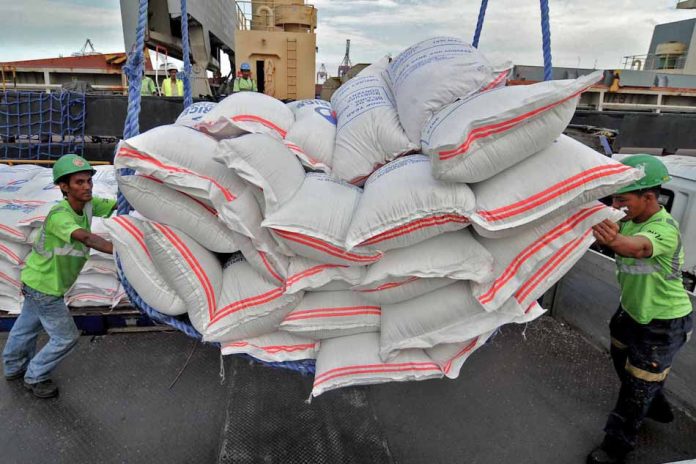
MANILA – The Alyansa ng Industriyang Bigas (ANIB) made it clear that they are opposed to rice trade liberalization as it is detrimental to Filipino farmers and traders.
The Rice Tariffication bill, approved by the congressional bicameral conference committee, is one step away from being enacted by the Duterte administration. All it needs now is the President’s signature.
“Changing the landscape of the grains industry by allowing everybody, including the big corporations and entities, to import rice will be dangerous and harmful to local producers and traders,” ANIB president Victoriano Catapang said.
The industry stakeholder’s group issued the statement after the Bicameral Conference Committee approved the Rice Tarrification Bill, which was certified as urgent by President Rodrigo Duterte.
The bill replaces quantitative restrictions on rice imports with tariffs.
It imposes a 35-percent tariff on rice imports from neighboring members of the Association of Southeast Asian Nations (ASEAN).
The measure paves the way to full liberalization of the country’s rice trading, practically opening the sector to any individual or group as long as a pythosanitary permit is secured from the Bureau of Plant Industry – an attached agency of the Department of Agriculture – and the tariffs are paid.
A phytosanitary certificate is an official document indicating that consignments of plants, plant products or other regulated articles meet specified phytosanitary import requirements, and conforms to the requirements of the importing country, according to the US Department of Agriculture.
Quantitative restrictions
In June 2017, the Duterte administration decided to drop the quantitative restrictions on rice importation under the World Trade Organization.
To give local farmers more time to prepare for free trade, the World Trade Organization (WTO) gave the Philippines until June 30, 2017 to implement the QR on imported rice. QR is a non-tariff measure to limit the volume of imports of a specific product.
In 1995, the WTO first allowed the Philippines to impose a 10-year QR on rice importation. In 2004, it was extended to 2012 and renewed in 2014.
“Removing the trading function and control of importation from the National Food Authority will create havoc and chaos in the grains industry,” Catapang emphasized.
The Rice Tariffication bill, once enacted, will strip the National Food Authority of its regulatory functions, said Tomas Escarez, NFA administrator and officer-in-charge.
“NFA will be left only with the function of buffer stocking, at an undetermined volume, for calamities and emergencies. Source of inventory is local procurement, as NFA is prevented from importing rice to maintain a safe level of buffer stocks at all times,” Escarez said.
Farmers will incur annual losses of P60 billion with the unabated entry of cheap imported rice, the NFA chief said, citing estimates by a farmers’ group.
Rice fund
To shield local farmers from the impact of liberalized trade, the Rice Tariffication bill earmarks P10 billion for the Rice Competitiveness Enhancement fund, of which P5 billion will be allotted to farm mechanization and P3 billion to seedlings.
The fund intends to ensure that rice imports won’t drown out the agriculture sector and rob farmers of their livelihood.
Escarez, however, said the amount is simply not enough and “is not even intended as direct subsidy to farmers.”
In a separate statement, Socioeconomic Planning Secretary Ernesto Pernia said that if tariff revenues exceed P10 billion in any given year, the excess revenue will still be plowed back to Rice Competitiveness Enhancement Fund (RCEF) to support rice farmers.
“The RCEF will be used to provide key interventions to support our farmers and enhance their competitiveness, including farm machinery and equipment to improve farm mechanization, rice seed development, propagation and promotion, expanded rice credit, and extension services,” Pernia said.
ANIB said rice trade liberalization must be limited and the NFA’s trading function and control of rice importation maintained.
Government intervention will be limited to buffer stocking in case of emergency and disaster relief, Escarez noted.
“This means that the government will no longer use buffer stocks to stabilize rice price and supply and ensure access of the poor to affordable quality rice,” Escarez said.
Duterte’s economic managers are pushing for rice tariffication amid soaring inflation, partly due to supply side factors as rice prices skyrocketed when the NFA failed to secure enough rice to stabilize prices in the market.
The economic managers estimated that liberalized trade will lower inflation by 0.4 to 0.7 percentage points, and slash the price of rice by as much as P7 per kilogram.
“The economic team has always been mindful that food remains to be the major contributor to inflation. Efforts to address food supply concerns, especially rice, will definitely help bring down consumer prices,” Pernia said.
A study by the Philippine Institute for Development Studies showed that rice accounts for about 35 percent of the total food intake of Filipinos, and about 85 percent of all cereals consumed.
The poorest income sector spends about 47.5 percent of their food expenses on rice. (GMA News/PN)



